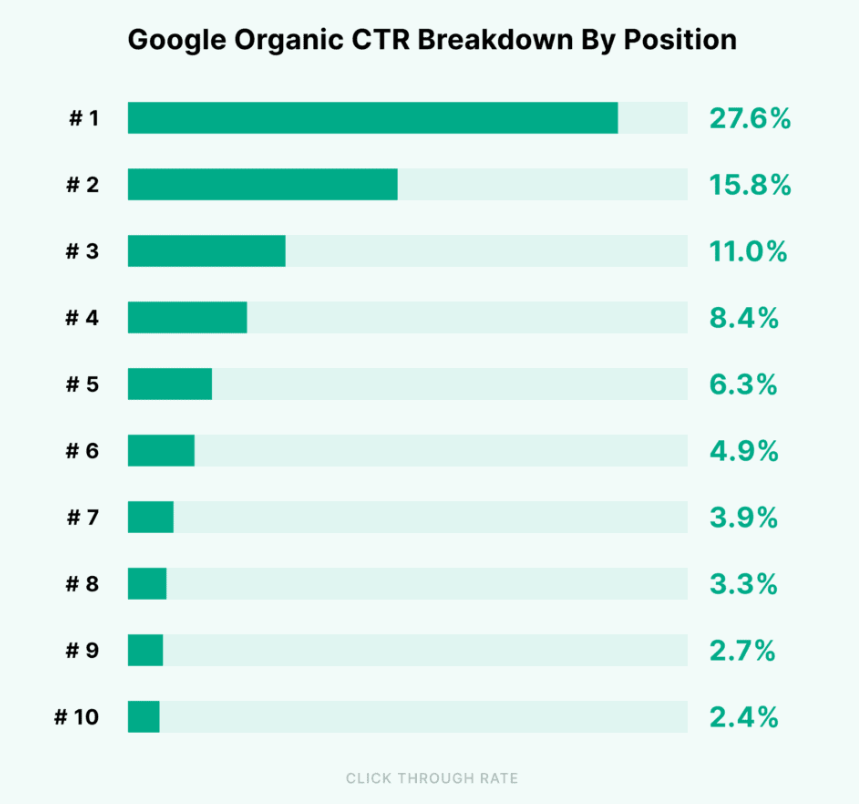Search engine optimization is an infamously tumultuous discipline — and it’s rarely been quite as chaotic as in the past year.
Between Google’s algorithm updates, the rise of generative engines, and the rapid proliferation of AI-generated content, it can feel like the whole SEO playbook has been thrown out the window.
Despite the continued, seismic changes rocking the SEO world today, the key SEO traffic analysis metrics haven’t changed. In fact, as competition continues to increase and the SERP shrinks, performance indicators like keyword rankings, organic trends, and click-through rate are becoming more important than ever.
So keep your eye on the ball! No matter the state of SEO or your website, you can and will glean valuable insights about how to grow your qualified traffic if you pay close attention to these evergreen indicators of SEO health.
Analyzing SEO traffic: 4 key metrics to track
Keyword rankings
Keyword rankings show where your web pages appear on the corresponding keyword’s search engine result pages (SERPs). The higher your keyword ranking, the higher your page appears in the SERP. This matters because the higher your rank, the more likely users are to click through to your site from the SERP.
For example, the No. 1 result on a Google SERP receives an average of 27.6% of all clicks on that SERP, and users are an average of 10x more likely to click on this top result than they are to click on a page even as few as nine links (or ranks) below it. Meanwhile, only 0.63% of Google searchers click on a link on the second page of a SERP (ranks 11+).
In simple terms, this explains why it’s vital to focus on ranking highly for keywords that are relevant to your buyers and their journey. Tracking keyword rankings should be an ongoing activity because SERPs are not static. When you’re losing ground, competitors are likely gaining it.
Learn more about how to research keywords for your B2B SEO strategy.
Organic traffic
Organic traffic refers to visits to your website sourced from unpaid search results. This makes it one of the most direct and important metrics for determining the success of your SEO strategy.
Keeping track of organic traffic becomes even more valuable when you can cross-reference it with your keyword ranking performance. If you’re approaching your SEO strategy correctly, there should be a strong correlation between your keyword rankings and your organic traffic performance. If your strong keyword rankings aren’t driving traffic or conversions, it may be a sign you’re targeting terms that lack demand or relevance.
Another key indicator of the health of your SEO strategy is the percentage of your overall web traffic that comes from organic search. Being free, organic traffic is the most sustainable form of web traffic you can pursue in the long term. Though this will vary depending on your industry and subject matter, a good general rule is that at least 50% of your web traffic should be organic in any given month.
If you notice a decline in organic traffic that doesn’t correlate directly with a loss of keyword rankings, your click-through rate should be the next metric you check.
Click-through rate
Your organic click-through rate, or CTR, is a measurement of the percentage of search engine users who click on, or “click through,” to your web page after finding it on a SERP. You can calculate your CTR by dividing the number of clicks on a SERP listing by the number of impressions it gets and then multiplying the result by 100.
CTR is a critical SEO metric because it’s the most direct way to measure how relevant the audience searching for your keywords finds your content. The higher your CTR, the more confident you can feel that your audience finds the content appearing in SERPs relevant to what they were looking for.
A Backlinko study of more than 4 million Google search results conducted in 2023 found the following generalized benchmark CTRs by SERP position: 
Source: Backlinko
These are only broad benchmarks. Click-through rates will vary widely based on your keyword, industry, or subject matter. For example, you can expect branded keywords (such as the name of your organization) to have much higher CTRs than generalized keywords, because anyone searching for your brand by name is probably looking for your website.
If your CTRs are consistently low, even if you’re landing on page 1 of your intended SERPs, it’s a sign that your pages aren’t drawing in the people who are searching for your keywords. In that case, you should re-evaluate how you present these pages on the SERPs, starting with your metadata.
Organic conversion rate
While keyword rankings, organic traffic and click-through rate are all good indicators of SEO success, they don’t mean much to your business on their own. Driving conversions is the name of the game, and where the real impact is seen.
Conversions can take many shapes and forms, whether it’s downloading a gated asset, registering for a webinar, requesting a demo, or even making a purchase. However you define these valuable actions, it’s important to measure the rate at which your organic visitors are converting against the overall baseline for web traffic.
When organic conversions are outpacing the overall standard, that tells you that your SEO strategy is working. It means you’re attracting the right visitors, and giving them the right experience. And because these visitors are free to acquire, these conversions are highly cost-efficient.
There are plenty of other, deeper SEO traffic analysis metrics you can and should track, but at a basic level, these four in combination will tell you whether or not your strategy is working.
Interested in digging deeper into your website’s SEO health? Following our guide to conducting a full SEO analysis of your website.



